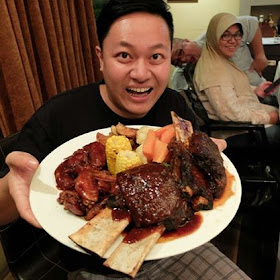Fun with Paellas ~~ Mastering the Art of Cooking Paella !
Tuesday, November 13, 2012
Paellas are one of my favourite things to eat! It’s an exotic rice dish hailed from Spain, usually served in a big pan, in the middle of the table where everyone grabs a spoon and scrape all the goodness from the pan. Even though Paella is a dish from Europe, this dish has found itself served in Spanish theme restaurants around South East Asia. Having eaten a fair share of paellas around Malaysia, I have to admit, they are quite disappointing. They tend to be in served in small portions, with soggy rice, lacking flavour and without the iconic soccarat – that slightly charred caramelized bits at the bottom of the pan (similar to the charred bits in a good claypot rice dish). 
I was overjoyed to receive this box of goodies in the mail! Thanks Esther!
I met a Spanish friend when they came to visit Brunei through my blog and I showed them around Brunei’s food establishments. I told her about the difficulty to find good paella around Borneo, and she asked – why not just make your own? She proceeded to send me three good paella pans, and a box of ingredients to cook paella! Oh Joy! 
Nori Pepper Flakes adds a fragrant spicy punch to your paellas!
I set out to research and prepare my ingredients for Paella. The authentic paellas requires special short grain rice from Spain but I find that using Sushi Rice or Italian Arborio Rice works fine. For the soup stock, some suggest making a fish stock for seafood paellas and chicken stock for the chicken paellas. For my stock, I made a soup stock using chicken bones, celery, carrots and onions – simple straight forward stock – nothing too fancy.
Pureed onions cooked under slow heat to draw out the moisture and enhancing the flavour.
Most of the experts agree that a good flavour base is important to make a good paella. This is called Sofrito – usually a tomato based sauce. For my sofrito, I used about 2 cups of onions, 3/4 cup of garlic with 200ml of oil, 4 cups of tomatoes – all pureed separately, Nori pepper flakes, pimento or sweet paprika, salt and pepper to taste. If you are feeling generous, you can add perhaps some saffron threads to your sofrito.
You first cook the pureed onions on a slow medium heat, taking care not to burn them, and stirring till the moisture is less, then add in your garlic oil emulsion, repeating the process, then your tomatoes and other ingredients.

Slow and steady wins the race for this part
Once the sauce has reach a more thick consistency, I actually take out my stick blender and blend them some more for a smoother consistency.
Smooth, thick and fragrant Sofrito is created! You can actually jar these and freeze them!
This sofrito will form the base for most of my paellas although for fusion paellas like my laksa paella, I use laksa paste and daun kesum pesto as my base. Store them in jars to be kept for future use. They freeze pretty well so I make quite a big batch every time.
Some people like to cook their paellas on a stove top, but I don’t like it as the heat distribution will be too concentrated on the center of the pan – finishing the paella in the oven is something that might dry our the paella too. I prefer my paellas cooked on a hot grill!
Sear your meats early for that charred caramelized taste – and also adds flavour to your paella!
Place your paella pans on your heated grill and close the lid to preheat the pans – depending on your grill, this could take 5 to 10 minutes. As long as your pans get smoky once you pour your cooking oil, you are ready to go.
At this moment, it is a good time to sear your meat for that caramelized goodness – your chicken, pork or in my case – scallops. I pan fry them to sear them a bit and then take off the heat, because I will finish cooking them later with the paella – you don’t want to overcook your scallops!
Frying the delicious sofrito on hot paella pans!
The next step is to fry your aromatics: onions, garlic and mushrooms – then add your sofrito or flavour base. Fry it a little bit till fragrant – then add in your medium grain rice – as I mentioned – I usually use medium grain sushi rice or Australian calrose rice. I usually add them in a cross pattern before mixing them together with the flavour base.
Some Spanish bloggers say this cross pattern is to bless the paella ~~ lol ~~
Once the rice is coated with the flavour base and has heated up nicely. You can add your stock. As I mentioned – a good home made stock is usually better than a store bought one as you can control your amount of sodium and flavour. I usually scoop just about enough to cover the rice and I add more later when I add the seafood – if you’re cooking with meats, add your meats now. Cover and keep the heat on for around 15-20 minutes (this depends on your grill – but for mine, I start checking at 13 minutes to check if they are getting too dry – if this happens ladle more stock and close lid). For meat paella, where you don’t add seafood – cook it for 20 minutes and check from 15 minutes onwards.
Add just enough to cover your rice and close the lid
Arrange your seafood before adding stock! They don’t take very long to cook.
After about 13-15 minutes, add and arrange your seafood and then add more stock – and close the lid – this sort of steams the seafood. Check in 5 minutes. NOTE: add your clams earlier as they might take longer time to cook than mussels. Maybe at the 10th minute.
This is my oysters, scallops and smoked salmon paella – I added the oysters and cover for 3 minutes first before adding the scallops, then add the smoked salmon (which does not require cooking) only when the paella is cooked. Add your seafood according to order they will be cooked.
This is my laksa paella (using laksa paste and daun kesum pesto sofrito base) – where I add the seafood – then add coconut milk then close the lid.

Clams, Chilean baby mussels and prawns paella – Seafood Tomato Sofrito base
After your paella is done – take it off the heat – garnish with basil leaves – or other herbs depending on your preference. Bon appetit! Using these simple formulas and techniques – you can create an array of paellas to suit your taste! There’s no fixed recipe but you adjust and experiment with it – that’s the fun! Below are some of the paellas I made!!

Smoked Salmon, Oysters and Scallops Paella – Tomato Sofrito Base. I loved the flavour smoked salmon gave to the rice!
Laksa Paella with prawns and squid – with Kuching Laksa paste, Daun Kesum Pesto, Coconut Milk Flavour base. Fusion Paella. A very popular paella amongst my friends.
Sliced marinated beef ribs(pan fried on paella pan), sliced Lap Cheong (Chinese dried sausages), long beans, with Indonesian style spicy chili sambal base. Indo-chine Paella!
Making use of leftover sukiyaki stock from a sukiyaki dinner night at my friends. The stock proved flavoursome and add a very Japanese flavour to this Sukyaki Paella – you can see bits of udon, with beef, seafood sticks and sliced eggplant – a paella made from leftovers!
Subscribe to:
Post Comments
(
Atom
)






















No comments :
Post a Comment